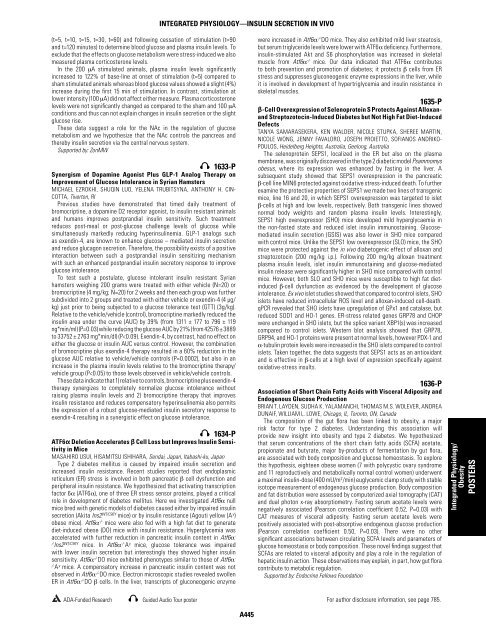2011 ADA Posters 1261-2041.indd - Diabetes
2011 ADA Posters 1261-2041.indd - Diabetes
2011 ADA Posters 1261-2041.indd - Diabetes
You also want an ePaper? Increase the reach of your titles
YUMPU automatically turns print PDFs into web optimized ePapers that Google loves.
(t=5, t=10, t=15, t=30, t=60) and following cessation of stimulation (t=90<br />
and t=120 minutes) to determine blood glucose and plasma insulin levels. To<br />
exclude that the effects on glucose metabolism were stress-induced we also<br />
measured plasma corticosterone levels.<br />
In the 200 μA stimulated animals, plasma insulin levels signifi cantly<br />
increased to 122% of base-line at onset of stimulation (t=5) compared to<br />
sham stimulated animals whereas blood glucose values showed a slight (4%)<br />
increase during the fi rst 15 min of stimulation. In contrast, stimulation at<br />
lower intensity (100 μA) did not affect either measure. Plasma corticosterone<br />
levels were not signifi cantly changed as compared to the sham and 100 μA<br />
conditions and thus can not explain changes in insulin secretion or the slight<br />
glucose rise.<br />
These data suggest a role for the NAc in the regulation of glucose<br />
metabolism and we hypothesize that the NAc controls the pancreas and<br />
thereby insulin secretion via the central nervous system.<br />
Supported by: ZonMW<br />
& 1633-P<br />
Synergism of Dopamine Agonist Plus GLP-1 Analog Therapy on<br />
Improvement of Glucose Intolerance in Syrian Hamsters<br />
MICHAEL EZROKHI, SHUQIN LUO, YELENA TRUBITSYNA, ANTHONY H. CIN-<br />
COTTA, Tiverton, RI<br />
Previous studies have demonstrated that timed daily treatment of<br />
bromocriptine, a dopamine D2 receptor agonist, to insulin resistant animals<br />
and humans improves postprandial insulin sensitivity. Such treatment<br />
reduces post-meal or post-glucose challenge levels of glucose while<br />
simultaneously markedly reducing hyperinsulinemia. GLP-1 analogs such<br />
as exendin-4, are known to enhance glucose – mediated insulin secretion<br />
and reduce glucagon secretion. Therefore, the possibility exists of a positive<br />
interaction between such a postprandial insulin sensitizing mechanism<br />
with such an enhanced postprandial insulin secretory response to improve<br />
glucose intolerance.<br />
To test such a postulate, glucose intolerant insulin resistant Syrian<br />
hamsters weighing 200 grams were treated with either vehicle (N=20) or<br />
bromocriptine (4 mg/kg; N=20) for 2 weeks and then each group was further<br />
subdivided into 2 groups and treated with either vehicle or exendin-4 (4 µg/<br />
kg) just prior to being subjected to a glucose tolerance test (GTT) (3g/kg).<br />
Relative to the vehicle/vehicle (control), bromocriptine markedly reduced the<br />
insulin area under the curve (AUC) by 39% (from 1311 ± 177 to 796 ± 119<br />
ng*min/ml) (P=0.03) while reducing the glucose AUC by 21% (from 42576 ± 3889<br />
to 33752 ± 2763 mg*min/dl) (P
















